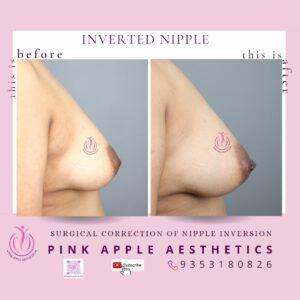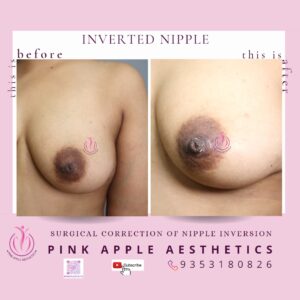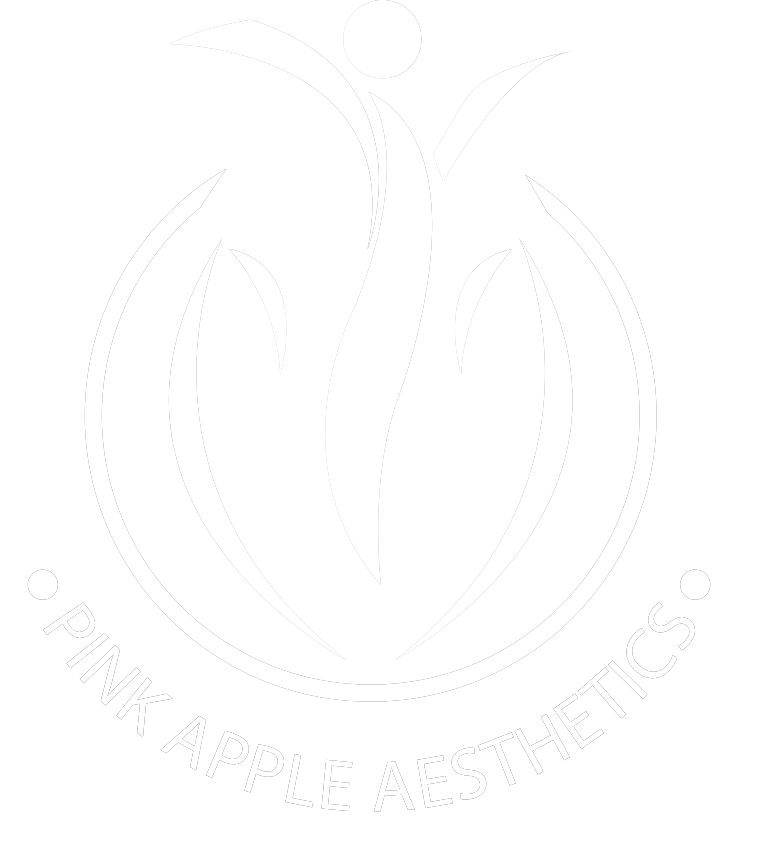If the nipple is inverted, it will be either flat against the areola or go inward instead of sticking out. Circular pigmented skin around the nipple is called areola. Inverted nipples are also called retracted nipples. For some people inverted nipples are congenital (born with them), whereas for others it develops later in life, which is an acquired inversion. Inverted nipples are the result of an imbalance in muscle traction, where the strength of the outward muscle is weaker than the inward, which can have a stronger pull, causing the nipple to remain retracted. Inverted nipples can be found among both males and females, though the latter have an increased propensity towards it. Sometimes, only one nipple is inverted. On account of inverted nipples, a person may face challenges such as breastfeeding issues or being unable to do so, depending on the degree of inversion. In this article we look at nipple inversion correction surgery to correct retracted or inverted nipples.


It is estimated that 10-20% of women has inverted nipples. If the condition is congenital, it occurs when breast tissue is stuck tightly to the base of the nipple, preventing it from sticking out. Congenitally, inverted nipples are largely harmless, though it can be problematic while breastfeeding. However, as for acquired inverted nipples (developing later in life), it could be a sign of an underlying serious medical condition like inflammation of breast tissue or even breast cancer. People should seek immediate medical attention if one or both nipples invert in a short period.
The following are some of the medical conditions that can cause inverted nipples:
- Mastitis, which is an infection of the mammary gland
- Duct ectasia, which is an abnormal dilation of a duct in the breast tissue
- An abscess under the areola
Breast cancer (as for breast cancer, there will be other telltale signs as well, such as a scaly, swollen nipple or nipple discharge)
If you are bothered by your inverted nipples, you needn’t! It can be de-inverted (corrected) with plastic/cosmetic surgery. More people than ever are opting to get it done. Of all the nipple correction surgeries, inverted nipple correction is the most common one. The procedure is gaining popularity not only as a medical procedure, but as a cosmetic surgery as well. Thanks to the increasing awareness about breast-related issues in the society.
Preparing for the surgery:
If you are seriously considering inverted nipple correction surgery, the first step is to fixing up an appointment with a plastic/cosmetic surgeon. Be frank during the consultation regarding your goals and expectations about the procedure. You will be asked about detailed past medical history, current health status, current medications, allergies and ongoing medical treatments, if any. If you are a potential candidate for the surgery, the procedure will be explained to you in detail. Feel free to clear any doubts regarding the procedure with your cosmetic surgeon.
How the surgery works?
Generally, inverted nipple correction is done as a day-case, meaning you can go home a few hours after the procedure, provided there are no complications. The anesthetist will decide the type of anesthesia in consultation with your cosmetic surgeon depending on the type and nature of the procedure.
The nipples are pulled out of their hiding places, following which the abnormally tight connections to the nipple are divided, and the nipple is sewn onto itself. Patients should be aware that post de-inversion, their nipples will be more prominent under clothing, something those with retracted nipples may not be used to dealing with.
However, if the nipple inversion is not that severe, there are other medical options for those seeking to change the look and feel of inverted nipples. Sometimes, a small fat graft or a product like Juvederm Voluma or Radiesse is injected under the nipple. It can help support the release and prevent the breast tissue from reattaching and narrowing again. Also, a nipple ring can be placed to help hold the nipple in the ‘out’ position. Over time, as tissues heal in this position, the nipple ring can be taken out.
Recovery phase:
If dissolvable sutures are used, there is no need for suture removal. There may be swelling around the operated site with mild discomfort. That is common post procedure and it will go away after a couple of weeks. Follow the instructions given by the cosmetic surgeon for speedy recovery. You can see the results immediately post-surgery, though it may be marred with swelling. You can see the complete result of the procedure once the swelling clears off. Daily activities can be resumed after two days, but make sure you don’t do anything strenuous until the swelling subsides completely.
Will there be scarring post surgery?
Though scar is an inevitable part of any surgery, there won’t be any permanent scarring – it would be inconspicuous and fade over time. Moreover, incisions are made in such a way that scars become less noticeable as they fade.
Breastfeeding after inverted nipple correction:
In majority of cases, breastfeeding remains intact after nipple correction as long as the inversion is not severe and the surgery does not involve milk ducts. It is highly subjective. Your surgeon is the right person to clear your doubt regarding breastfeeding post-surgery.
Benefits of nipple correction surgery:
- Enhanced self-esteem
- Improved quality of life
- Overall improvement in appearance, intimacy and general social situations
Most people opting for Inverted nipple correction surgery for cosmetic reasons, prefer to couple it with procedures like breast augmentation, breast lift or breast reduction to give an overall enhancement to the appearance of breasts.
For Enquiries and Online Appointments
For more detailed information about the Inverted Nipple Correction, please send us a message today.

